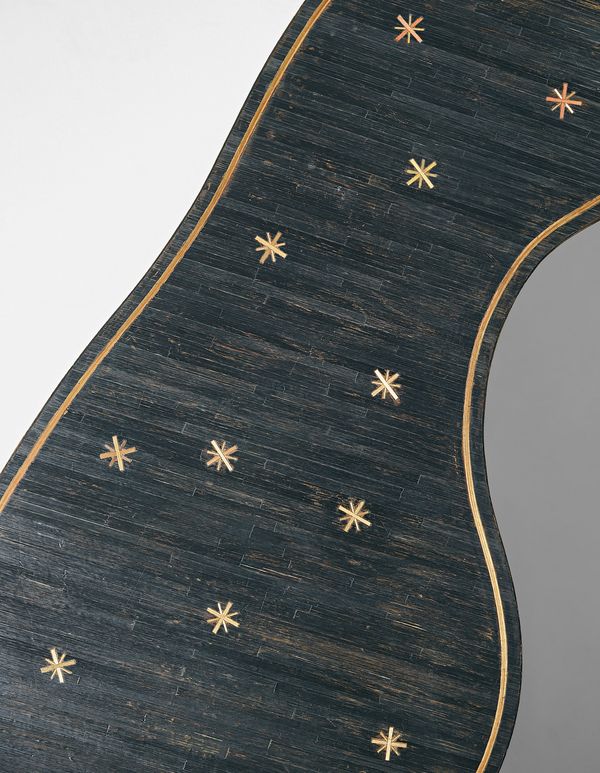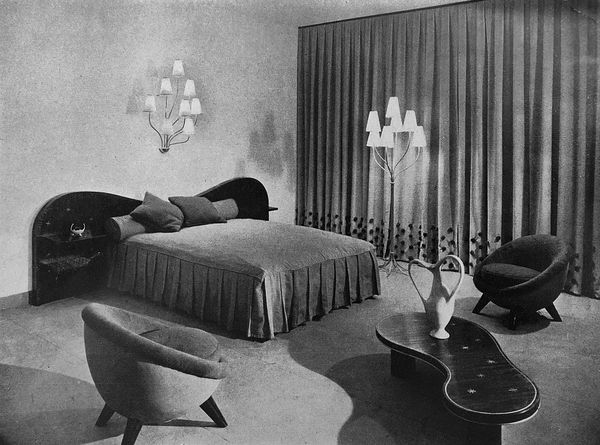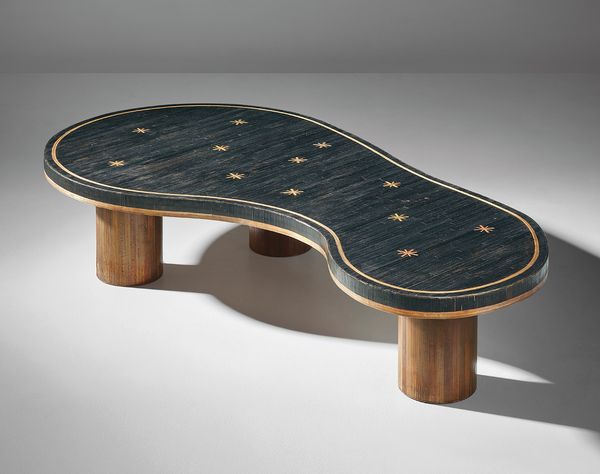Jean Royère "Flaque" low table, circa 1955
A Design highlight this spring season, the "Flaque" table—French for puddle—takes a freeform shape that illustrates the influence of biomorphism introduced by artists such as Hans Arp and Alexander Calder and situates Jean Royère's design within a larger international discourse.
From the 1930s, designers including Frederick Kiesler, Eileen Gray, Charlotte Perriand and Isamu Noguchi began exploring biomorphism in their work, departing from more traditional furniture forms. Technical innovations, such as plywood and tubular metal, assisted in the creation of these unconventional, organic forms. However, for Royère's "Flaque" table, the designer employed straw marquetry, a traditional technique meant to imitate wood veneer that had been in use in Europe since the seventeenth century. Revitalized by designers such as Jean-Michel Frank and André Groult during the 1930s, the technique of straw marquetry enabled Royère to combine color, pattern and craftsmanship, transforming a humble material into a sophisticated design. During the following decades, Royère would create several variations of the "Flaque" table, incorporating different materials and varied colors and ornamentation.

In 1947, for his own residence on the Faubourg-Saint-Honoré in Paris, Royère designed his first pieces of biomorphic furniture, an "Ours Polaire" sofa and a "Flaque" low table. The latter featured an opaline glass top decorated with red stars and supported by three perforated sheet metal legs, positioned in the designer's living room alongside a carpet whose fluid form echoed that of the low table. A few years later, Royère presented a version of the table with a blue opaline glass top as part of his design for an office lounge at the 1949 Salon des artistes décorateurs. These versions of Royère's "Flaque" table from the 1940s illustrate the connection to the biomorphic forms developed by designers during the 1930s, such as the series of coffee tables designed by Gray with irregularly shaped wooden or metal tops on tubular steel frames.
During the 1950s, Royère developed his repertoire of freeform designs, substituting the use of metal with straw marquetry, thus enabling him to introduce new ornamentation into these works, characterized by supple lines and delicate star motifs. In 1943 at the Salon d'automne, Royère presented his first piece of straw marquetry furniture—a cabinet with red and green stars composed of thin strips of straw. For his presentation at the 1954 Salon des arts ménagers, Royère exhibited a "Flaque" low table featuring black straw marquetry and enlivened with multi-colored stars uniformly positioned across the tabletop. For the furnishings of a villa in Pontault-Combault (1955-1958), Royère paired a cabinet and "Flaque" low table, each decorated with straw marquetry and featuring the multi-colored star motif. Set against matte ivory-colored walls within a sparsely decorated foyer, the pieces illustrate a return to simplicity in Royère's work of the 1950s.

The present model table exhibited in the Salon des art ménagers, Paris, 1954
Such works, as demonstrated by the present lot in our New York Design sale on 6 June, feature pared-down forms given expression and defined within space through their materials, reflecting Royère's captivation with ornamentation and his enduring independent expression.
